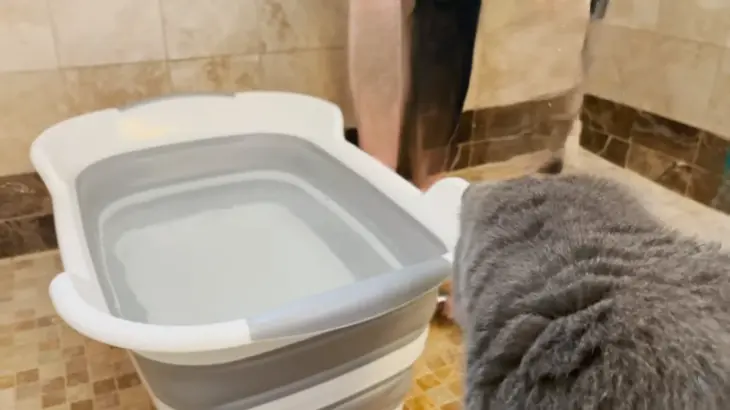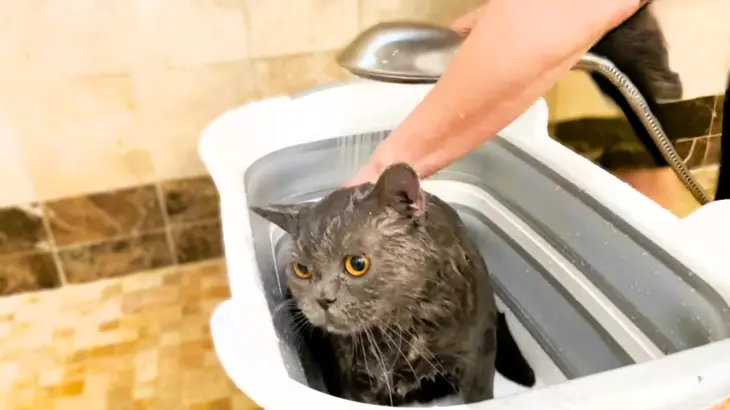How To Bathe A Cat: Step-By-Step Tips For A Stress-Free Experience
Bathe your cat by preparing warm water, finding a safe space, using cat-safe shampoo, and washing from neck to tail. Avoid the face and ears.
By: Elizabeth Rikas

The information in this article is intended to educate cat parents and is not a substitute for veterinary guidance. In case of any concerns about your cat’s health, please talk with your veterinarian.
Cats are naturally meticulous groomers, using their tongues, teeth, and paws to stay clean and fresh without much help from us. However, there are times when they need a little extra assistance—whether they’ve rolled in something sticky, picked up a few pesky parasites, or simply need a deeper clean.
Bathing cats not only helps them stay fresh but also plays a crucial role in grooming and protecting them from various skin conditions. However, the challenge arises when many cats resist baths, leaving their owners concerned and stressed. It’s a common issue.
Click to read: Do cats like to be petted?
As an experienced cat parent, i will be sharing here a few tips that worked for me in giving a drama free bath to my cat every time. With the right supplies, a calm demeanor, and a few clear steps, you can also give your cat a stress-free bath that leaves them truly clean and comfortable.
Why Bathe A Cat? – Feline Cleansing Reasons
Let’s look at why you might need to bath your cat, even though most cats don’t like water:
- Dirty or smelly coat: If your cat gets into something sticky, smelly, or potentially harmful, a bath might be necessary.
- Medical reasons: Some skin conditions or flea treatments require bathing.
- Overweight or elderly cats: These cats might have trouble grooming themselves effectively.
- Hairless breeds: Hairless cats like Sphynx need to be washed often. This is because their skin gets oily, and the oil builds up over time. Regular baths help keep their skin clean and healthy.
Remember, most cats don’t need frequent baths. Frequent baths can dry out their skin.
How Often Should You Bathe A Cat?
One of the most common questions cat owners ask is, “How often should I bathe my cat?” In general, cats only need a bath if they get very dirty or start to smell bad, and many cats can go their whole lives without ever needing one.
However, certain types of cats do require regular baths. Such as:
- Hairless cats: Breeds like the Sphynx typically need weekly baths to remove oil buildup on their skin.
- Long-haired cats: Since they cannot groom themselves, these cats might benefit from a bath every 4-6 weeks to prevent matting and excessive shedding.
- Outdoor cats: These cats might need a bath every 2-3 months, or more frequently as they often get dirty or smelly.
- Overweight cats: If a cat has difficulty grooming due to weight, they
might need a bath every 4-6 weeks, along with a veterinarian-approved diet plan. - Cats with medical conditions: Follow your veterinarian’s recommendations, which could range from weekly medicated baths to less frequent bathing with special shampoos.
Preparation For The Cat Bath
Getting everything ready before you start is important for a good cat bath. Let’s look at what you need and how to set things up to make bath time easier for you and your cat.

Your Supplies
Gather all your supplies before hand to avoid panic situation during the bath. The essential supplies include:
- Cat shampoo (never use human or dog shampoo for cats).
- Large towels.
- A non-slip mat.
- A cup or small pitcher for rinsing.
- Cotton balls for ear protection.
- Treats for rewarding good behavior.
Trim Your Cat’s Nails
Cut your cat’s nails before attempting a bath. Learn how to trim your cat’s nails. This will help prevent scratches if your cat becomes stressed.
Choose The Right Location
Decide where you’ll bathe your cat. Possible options include:

- Bathtub: Good for larger cats or if you prefer to kneel beside the tub.
- Kitchen sink: Ideal for smaller cats and kittens.
- Large basin or bucket: A portable option that can be used anywhere.
Make sure to choose a bathing spot, where your cat won’t slip and it’s safe for them.
Prepare The Bath Area
- Add some lukewarm water to the tub or sink, filling it only partway.
- Place a mat with a non-slip bottom in the tub to prevent your cat from slipping.
- Have all your supplies within easy reach.
Essential Steps In The Bathing Process
Now that you’re prepared, it’s time to bathe your cat. Let’s walk through each step to ensure your cat gets clean with minimal stress:
1. Brush And Comb Your Cat
Before you begin the bath, give your cat a thorough brushing. This helps remove loose hair and tangles, making the bathing process smoother and easier.
2. Protect The Ears
In order to avoid water going into your cat’s ears, gently place half a cotton ball in each of your cat’s ears. This prevents water from getting in the ear canals, which can lead to ear infections.
3. Wet Your Cat
Using warm water, gently wet your cat’s body while avoiding its head. Steer clear of getting water on their face, as this can cause stress. You can use a cup or small pitcher to pour water over your cat, or a spray attachment if your cat is comfortable with it.
4. Apply Shampoo
Rub a little cat shampoo into your hands and softly work it through your cat’s coat. Begin at the cat’s neck. Then wash down to its tail, being careful to avoid the face. Focus on cleaning the extra dirty or stinky spots on your cat.
5. Rinse Thoroughly
Wash off all the shampoo with warm water, making sure your cat is fully rinsed. Because Soap left on your cat can hurt their skin or make them ill if licked later. Rinse your cat until no more soap comes off.
6. Clean The Face
Softly wipe your cat’s face with a wet cloth. Clean carefully near your cat’s eyes and nose. Never submerge your cat’s head in water or spray it directly.
7. Dry Your Cat
Dry your cat with a big, soft towel by wrapping it up and patting it softly. Many cats fear blow dryers, but some might accept it in low, cool settings. If you use a dryer, introduce it slowly and stop if your cat seems stressed.
Instructions After The Cat Bath

Once the bath is over, there are a few more steps to ensure your cat is comfortable and the experience ends positively:
Keep Your Cat Warm
After the bath, keeping your cat warm is important until they’re completely dry. Here are some ways to do that:
- Keeping them in a warm room.
- Wrapping them in a fresh, dry towel.
- Letting them sit on a heating pad set to low (always supervised).
Brush Again
After drying, brush your cat softly again. Brushing spreads skin oils and stops knots in long-haired cats’ fur.
Reward Your Cat
After the bath, offer your cat treats, praise, and extra cuddles (if they’re receptive). Rewarding your cat with treats helps create a positive association with the bath and makes the experience more enjoyable for them.
Tips To Make Cat Bathing Easier?
Most of the cats don’t like water, which makes bathing them a daunting task. Let’s look at some ways to help your cat feel better about baths and make the process easier for both of you:
- Take a gradual approach to get your cat used to water, starting with small amounts and increasing as they become more comfortable.
- Stay calm while bathing – your cat can feel your mood.
- Feed your cat snacks during bath time to make it feel good.
- For minor cleaning, try waterless shampoo, this can be a good alternative
When To Seek Professional Help?
Sometimes, bathing a cat at home isn’t the best option. Consider professional grooming if:
- Your cat gets very upset or aggressive while bathing.
- You have mobility issues that make cat bathing difficult.
- Your cat needs special medicated baths due to some skin problem.
- You’re not confident in your ability to bathe your cat safely
Professional groomers and some veterinary clinics offer bathing services for cats.
Tips For Bathing Different Types Of Cats
Not all cats are the same, so bathing them can be different too. Some helpful tips for washing different kinds of cats, like those with long fur or older cats.
Long-Haired Cats
- Brush your cat thoroughly before and after the bath to prevent tangles and keep their fur smooth.
- Use a detangling spray if necessary.
- Consider using a conditioner made for long-haired cats.
Short-Haired Cats
- These cats typically need less frequent baths.
- Focus on problem areas, as their coats are generally easier to clean.
Kittens
- Use extra-gentle, kitten-specific shampoo.
- Keep baths brief and efficient.
- Be extra careful to keep water out of eyes, ears, and nose.
Senior Cats
- Be gentle, as older cats may have sensitive skin or joint pain.
- Consider using a shower spray attachment for easier rinsing.
- Keep the bathing area extra warm to prevent chilling.
Frequently Asked Questions
Conclusion
In summary, bathing your cat can be a calm experience for both you and your pet with the right preparation, patience, and gentle handling. Most cats don’t require regular baths, so only bathe them when it’s truly needed. If you’re unsure about how to properly clean your cat, consult your veterinarian for guidance.

About the Author
Elizabeth Rikas
Elizabeth is a passionate advocate for feline health and well-being, drawing from her years as a dedicated pet parent to three cats—Gypsy, Swan, and Alfred—and her invaluable experience volunteering at animal shelters. A seasoned writer with a lifelong love for cats, Elizabeth began sharing her insights in her teens and has since contributed extensively to platforms focused on feline care. Through her expertise and heartfelt dedication, she empowers pet owners with practical advice and research-backed knowledge to nurture their furry companions.
